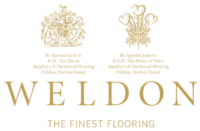These terms describe wood flooring composed of mosaics of pieces arranged for decorative effect, often in geometric patterns. Strictly speaking, any designs employing non-linear pieces are considered marquetry, though parquetry is often used as a catch-all term for decorative wood floors.
Parquetry became de rigueur in the formal rooms of stately homes across Europe, most notably the Palace of Versailles, from the 17th century, and synonymous with fine English interiors from the reign of King Charles I onwards. Weldon’s parquetry floors continue the tradition, bringing warmth, finesse and a classical elegance to a range of interior styles; we have a huge library of parquet designs, both ancient and modern, which we make to any size to fit perfectly the proportions of a room. As leaders in the field, we are frequently asked to restore original parquet flooring, reconditioning the antique timbers to our own exacting standards while preserving the character and charm acquired over centuries of use.
Marquetry is most associated with exquisite fine furniture and objects commissioned by wealthy patrons through history, dating back at least four millennia to Ancient Egypt. Used in flooring, marquetry techniques bring breath-taking artistry to the architecture of a building, but the skill of architectural marquetry is the preserve of just a handful of craftsmen worldwide; Weldon ranks among them. We have completed many private marquetry commissions; a public example of our work is the Royal Cypher in the Crimson Drawing Room at Windsor Castle, which is periodically open to the public for viewing.
We have seen a resurgence in interest in decorative wood flooring on all manner of projects over recent years; it is no longer the preserve of grand houses, and a curated selection of parquet panels and marquetry tiles is also available in engineered form.



